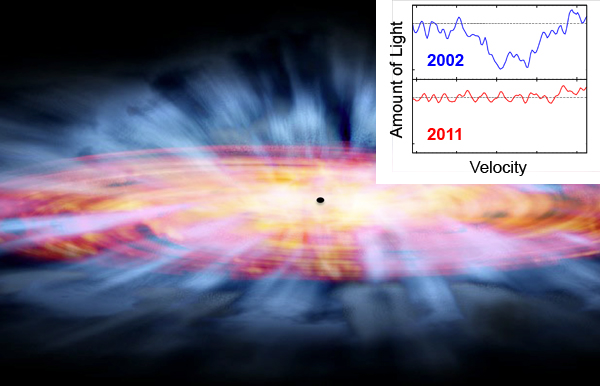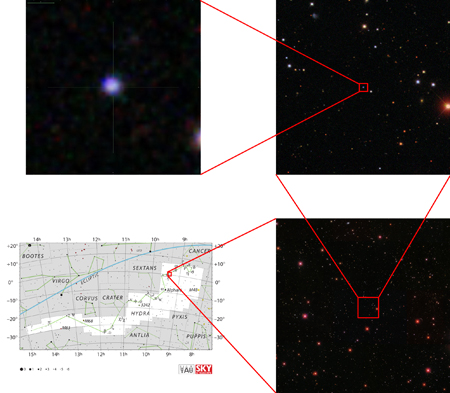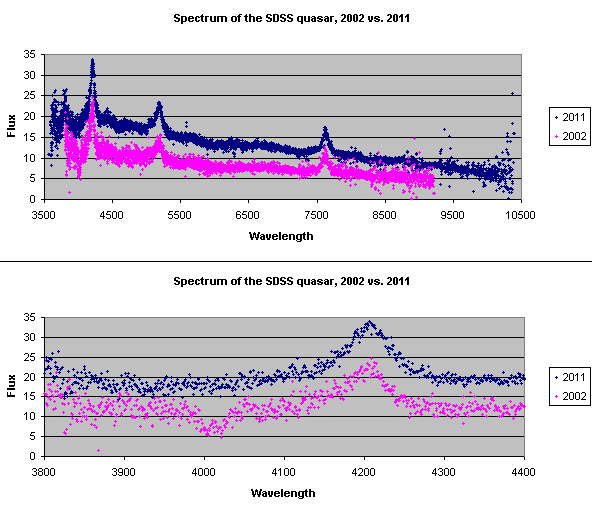The case of the missing quasar gas clouds has been solved by a worldwide team of astronomers, and the answer is blowin’ in the wind.
Astronomers Nurten Filiz Ak and Niel Brandt of the Pennsylvania State University led the team, which announced their results in a paper published in today’s issue of The Astrophysical Journal. The paper describes 19 distant quasars in which giant clouds of gas seemed to disappear in just a few years.
An artist’s impression of a quasar like one of the nineteen found by this study.
The black dot in the center represents the supermassive black hole at the center of the quasar. The red-and-yellow spiral surrounding it shows the accretion disk of hot gas falling into the black hole. Some of this gas is ejected as the quasar’s wind, which is shown in light blue. The size of the accretion disk shown is comparable to the size of our Solar System.
The inset at the top right shows two SDSS spectra for the same quasar (named SDSS J093620.52+004649.2). The upper spectrum (blue) was taken in 2002, while the lower spectrum (red) was taken in 2011. The deep, wide valley in the 2002 spectrum is a so-called “broad absorption line” — a feature which has disappeared from its spectrum by 2011.
Credit: NASA/CXC/M. Weiss, Nahks Tr’Ehnl, Nurten Filiz Ak
“We know that many quasars have structures of fast-moving gas caught up in ‘quasar winds,’ and now we know that those structures can regularly disappear from view,” says Filiz Ak, a graduate student at Penn State and lead author of the paper. “But why is this happening?”
Quasars are powered by gas falling into supermassive black holes at the centers of galaxies. As the gas falls into the black hole, it heats up and gives off light. The gravitational force from the black hole is so strong, and is pulling so much gas, that the hot gas glows brighter than the entire surrounding galaxy.
But with so much going on in such a small space, not all the gas is able to find its way into the black hole. Much of it instead escapes, carried along by strong winds blowing out from the center of the quasar.
“These winds blow at thousands of miles per second, far faster than any winds we see on Earth,” says Niel Brandt, a professor at Penn State and Filiz Ak’s Ph.D. advisor. “The winds are important because we know that they play an important role in regulating the quasar’s central black hole, as well as star formation in the surrounding galaxy.”
An SDSS image of the quasar SDSS J093620.52+004649.2, one of the 19 quasars with disappearing BAL troughs.
The constellation map on the bottom left shows the quasar’s position in the constellation Hydra. Three successive views zoom in closer and closer to the quasar.
Credit: Jordan Raddick (Johns Hopkins University) and the SDSS-III collaboration. Hydra constellation chart from The Constellations, produced by the International Astronomical Union and Sky and Telescope magazine (Roger Sinnott, Rick Fienberg, and Alan MacRobert)
Many quasars show evidence of these winds in their spectra — measurements of the amount of light that the quasar gives off at different wavelengths. Just outside the center of the quasar are clouds of hot gas flowing away from the central black hole. As light from deeper in the quasar passes through these clouds on its way to Earth, some of the light gets absorbed at particular wavelengths corresponding to the elements in the clouds.
As gas clouds are accelerated to high speeds by the quasar, the Doppler effect spreads the absorption over a broad range of wavelengths, leading to a wide valley visible in the spectrum. The width of this “broad absorption line (BAL)” measures the speed of the quasar’s wind. Quasars whose spectra show such broad absorption lines are known as “BAL quasars.”
But the hearts of quasars are chaotic, messy places. Quasar winds blow at thousands of miles per second, and the disk around the central black hole is rotating at speeds that approach the speed of light. All this adds up to an environment that can change quickly.
Previous studies had found a few examples of quasars whose broad absorption lines seemed to have disappeared between one observation and the next. But these quasars had been found one at a time, and largely by chance — no one had ever done a systematic search for them. Undertaking such a search would require measuring spectra for hundreds of quasars, spanning several years.
Contacts
- Nurten Filiz Ak, Pennsylvania State University, nfilizak -at- psu.edu, +1 814 865 4536
- Niel Brandt, Pennsylvania State University, niel -at- psu.edu, +1 814 865 3509
- Pat Hall, York University, phall -at- yorku.ca, +1 416 736 2100 x77752
- Michael Wood-Vasey, University of Pittsburgh, SDSS-III Scientific Spokesperson, wmwv@pitt.edu, (412) 624-2751
- Jordan Raddick, SDSS Public Information Officer, Johns Hopkins University, raddick@jhu.edu, (443) 570-7105
Enter the Sloan Digital Sky Survey (SDSS). Since 1998, SDSS has been regularly measuring spectra of quasars. Over the past three years, as part of SDSS-III’s Baryon Oscillation Spectroscopic Survey (BOSS), the survey has been specifically seeking out repeated spectra of BAL quasars through a program proposed by Brandt and colleagues.
Their persistence paid off — the research team gathered a sample of 582 BAL quasars, each of which had repeat observations over a period of between one and nine years – a sample about 20 times larger than any that had been previously assembled. The team then began to search for changes, and were quickly rewarded. In 19 of the quasars, the broad absorption lines had disappeared.
What’s going on here? There are several possible explanations, but the simplest is that, in these quasars, gas clouds that we had seen previously are literally “gone with the wind” —the rotation of the quasar’s disk and wind have carried the clouds out of the line-of-sight between us and the quasar.
And because the sample of quasars is so large, and had been gathered in such a systematic manner, the team can go beyond simply identifying disappearing gas clouds. “We can quantify this phenomenon,” says Filiz Ak.
Finding nineteen such quasars out of 582 total indicates that about three percent of quasars show disappearing gas clouds over a three-year span, which in turn suggests that a typical quasar cloud spends about a century along our line of sight. “Since the universe is 14 billion years old, we’re used to astronomical phenomena lasting a very long time,” says Pat Hall of York University in Toronto, another team member. “It’s fascinating to discover something that changes within a human lifetime.”
Now, as other astronomers come up with models of quasar winds, their models will need to explain this 100-year timescale. As theorists begin to consider the results, the team continues to analyze their sample of quasars — more results are coming soon. “This is really exciting for me,” Filiz Ak says. “I’m sitting at my desk, discovering the nature of the most powerful winds in the Universe.”
See it for yourself!
The three links below will take you to an interactive spectrum viewer for three spectra of this quasar, measured by the Sloan Digital Sky Survey on three different nights. The spectra are labeled at the bottom in Ångstroms — one Ångstrom equals one ten-billionth of a meter.
Zoom in on the area of each spectrum around 4000 Ångströms. In that area, you should see a broad valley in the 2001 and 2002 spectra — a valley that is gone from the 2011 spectrum!
Spectrum measured on April 28, 2001
Are you a teacher? Help your students see it themselves!
Spectra for the quasar shown on this page are available as CSV (comma-separated value) files, which can easily be opened in many common graphing programs, including Excel. That means that your students can plot the spectra and discover the disappearing BAL trough themselves.
The links below will take you to the SkyServer Quick Look entry for the three spectroscopic observations of the quasar. From there, click Get spectrum as CSV to get each file. When you open the files, you will see four columns of data; the first two are the most important. The first column, wavelength, is the wavelength of light measured. The wavelength is measured in Ångströms (1 Å = 10-10 m). The second column, flux, shows how much light the quasar gives off at that wavelength.
Load the 2002 and 2011 spectra onto the same spreadsheet. Then, make a graph with wavelength on the x-axis and flux on the y-axis. Make another graph another picture, zooming in on the wavelength region around 4000 Ångströms. The image below shows an example of what these graphs might look like.
Ask students: what do you see? What are some possible explanations for this observation?
Download the spectra
Spectrum measured on April 28, 2001
Spectrum measured on February 9, 2002
Images
An artist’s impression of a quasar like one of the nineteen found by this study.
The black dot in the center represents the supermassive black hole at the center of the quasar. The red-and-yellow spiral surrounding it shows the accretion disk of hot gas falling into the black hole. Some of this gas is ejected as the quasar’s wind, which is shown in light blue. The size of the accretion disk shown is comparable to the size of our Solar System.
The inset at the top right shows two SDSS spectra for the same quasar (named SDSS J093620.52+004649.2). The upper spectrum (blue) was taken in 2002, while the lower spectrum (red) was taken in 2011. The deep, wide valley in the 2002 spectrum is a so-called “broad absorption line” — a feature which has disappeared from its spectrum by 2011.
Credit: NASA/CXC/M. Weiss, Nahks Tr’Ehnl, Nurten Filiz Ak
An SDSS image of the quasar SDSS J093620.52+004649.2, one of the 19 quasars with disappearing BAL troughs.
The constellation map on the bottom left shows the quasar’s position in the constellation Hydra. Three successive views zoom in closer and closer to the quasar.
Credit: Jordan Raddick (Johns Hopkins University) and the SDSS-III collaboration. Hydra constellation chart from The Constellations, produced by the International Astronomical Union and Sky and Telescope magazine (Roger Sinnott, Rick Fienberg, and Alan MacRobert)
Acknowledgement
This material is based upon work supported by the National Science Foundation under Grant No. AST-1108604, “Large-scale investigations of quasar winds with the Sloan Digital Sky Survey-III.” Any opinions, findings, and conclusions or recommendations expressed in this material are those of the authors and do not necessarily reflect the views of the National Science Foundation.
About the Sloan Digital Sky Survey
Funding for SDSS-III has been provided by the Alfred P. Sloan Foundation, the Participating Institutions, the National Science Foundation, and the U.S. Department of Energy Office of Science. The SDSS-III web site is www.sdss3.org .
SDSS-III is managed by the Astrophysical Research Consortium for the Participating Institutions of the SDSS-III Collaboration including the University of Arizona, the Brazilian Participation Group, Brookhaven National Laboratory, University of Cambridge, Carnegie Mellon University, University of Florida, the French Participation Group, the German Participation Group, Harvard University, the Instituto de Astrofisica de Canarias, the Michigan State/Notre Dame/JINA Participation Group, Johns Hopkins University, Lawrence Berkeley National Laboratory, Max Planck Institute for Astrophysics, Max Planck Institute for Extraterrestrial Physics, New Mexico State University, New York University, Ohio State University, Pennsylvania State University, University of Portsmouth, Princeton University, the Spanish Participation Group, University of Tokyo, University of Utah, Vanderbilt University, University of Virginia, University of Washington, and Yale University.






